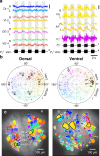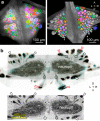Anatomy and activity patterns in a multifunctional motor neuron and its surrounding circuits
- PMID: 33587033
- PMCID: PMC7954528
- DOI: 10.7554/eLife.61881
Anatomy and activity patterns in a multifunctional motor neuron and its surrounding circuits
Abstract
Dorsal Excitor motor neuron DE-3 in the medicinal leech plays three very different dynamical roles in three different behaviors. Without rewiring its anatomical connectivity, how can a motor neuron dynamically switch roles to play appropriate roles in various behaviors? We previously used voltage-sensitive dye imaging to record from DE-3 and most other neurons in the leech segmental ganglion during (fictive) swimming, crawling, and local-bend escape (Tomina and Wagenaar, 2017). Here, we repeated that experiment, then re-imaged the same ganglion using serial blockface electron microscopy and traced DE-3's processes. Further, we traced back the processes of DE-3's presynaptic partners to their respective somata. This allowed us to analyze the relationship between circuit anatomy and the activity patterns it sustains. We found that input synapses important for all the behaviors were widely distributed over DE-3's branches, yet that functional clusters were different during (fictive) swimming vs. crawling.
Keywords: Hirudo verbana; connectome; motor behaviors; neural circuit; neuroscience; serial blockface electron microscopy; voltage-sensitive dye imaging.
© 2021, Ashaber et al.
Conflict of interest statement
MA, YT, PK, EB, WK, ME, DW No competing interests declared
Figures





















Similar articles
-
A cephalic projection neuron involved in locomotion is dye coupled to the dopaminergic neural network in the medicinal leech.J Exp Biol. 2004 Dec;207(Pt 26):4535-42. doi: 10.1242/jeb.01315. J Exp Biol. 2004. PMID: 15579549
-
Disruption of peripheral target contact influences the development of identified central dendritic branches in a leech motor neuron in vivo.J Neurobiol. 2000 Jun 15;43(4):365-78. J Neurobiol. 2000. PMID: 10861562
-
An oscillatory neuronal circuit generating a locomotory rhythm.Proc Natl Acad Sci U S A. 1976 Oct;73(10):3734-8. doi: 10.1073/pnas.73.10.3734. Proc Natl Acad Sci U S A. 1976. PMID: 1068483 Free PMC article.
-
Neuronal control of leech behavior.Prog Neurobiol. 2005 Aug;76(5):279-327. doi: 10.1016/j.pneurobio.2005.09.004. Epub 2005 Nov 2. Prog Neurobiol. 2005. PMID: 16260077 Review.
-
Neural control of heartbeat in the leech and in some other invertebrates.Physiol Rev. 1979 Jan;59(1):101-36. doi: 10.1152/physrev.1979.59.1.101. Physiol Rev. 1979. PMID: 220645 Review.
Cited by
-
The evolution of Big Data in neuroscience and neurology.J Big Data. 2023;10(1):116. doi: 10.1186/s40537-023-00751-2. Epub 2023 Jul 10. J Big Data. 2023. PMID: 37441339 Free PMC article.
-
Emergence of synaptic organization and computation in dendrites.Neuroforum. 2022 Feb 23;28(1):21-30. doi: 10.1515/nf-2021-0031. Epub 2021 Dec 31. Neuroforum. 2022. PMID: 35881644 Free PMC article. Review.
-
The hippocampal CA2 region discriminates social threat from social safety.Nat Neurosci. 2024 Nov;27(11):2193-2206. doi: 10.1038/s41593-024-01771-8. Epub 2024 Oct 15. Nat Neurosci. 2024. PMID: 39406949
-
The Thermodynamically Expensive Contribution of Three Calcium Sources to Somatic Release of Serotonin.Int J Mol Sci. 2022 Jan 28;23(3):1495. doi: 10.3390/ijms23031495. Int J Mol Sci. 2022. PMID: 35163419 Free PMC article. Review.
-
Current Practice in Using Voltage Imaging to Record Fast Neuronal Activity: Successful Examples from Invertebrate to Mammalian Studies.Biosensors (Basel). 2023 Jun 13;13(6):648. doi: 10.3390/bios13060648. Biosensors (Basel). 2023. PMID: 37367013 Free PMC article. Review.
References
-
- Bates AS, Schlegel P, Roberts RJ, Drummond N, Tamimi IFM, Turnbull R, Zhao X, Marin EC, Popovici PD, Dhawan S, Jamasb A, Javier A, Li F, Rubin GM, Waddell S, Bock DD, Costa M, Jefferis G. Complete connectomic reconstruction of olfactory projection neurons in the fly brain. bioRxiv. 2020 doi: 10.1101/2020.01.19.911453. - DOI - PMC - PubMed
Publication types
MeSH terms
Grants and funding
LinkOut - more resources
Full Text Sources
Other Literature Sources

